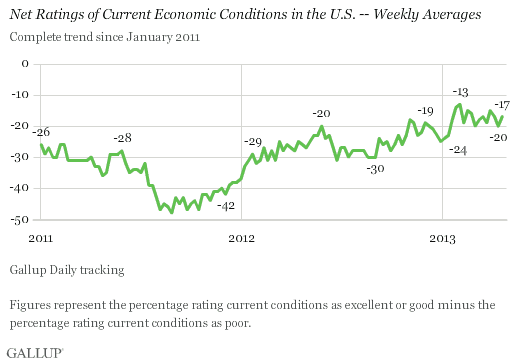WASHINGTON, D.C. -- The Gallup U.S. Economic Confidence Index was -14 last week, compared with -17 the prior week. The current score is six points below the five-year high of -8 reached in early February.

The Economic Confidence Index reached -12 -- the highest score since the five-year high -- in the last week of March, likely as a reaction to record-high stock prices, a boost in housing prices, and lower gas prices. This score was up from -22 at the end of February and beginning of March as Congress and the president failed to reach an agreement to avoid the sequestration spending cuts.
Gallup's Economic Confidence Index is based on Americans' ratings of current economic conditions in the United States as well as their assessments of whether the economy is getting better or worse. Americans' assessments of both index components inched up last week.
Americans' perceptions of current economic conditions remain more negative than positive. Their net current conditions ratings increased slightly to -17 from -20 the prior week. The latest reading reflects 18% of Americans saying the economy is excellent or good and 35% saying it is poor.

Americans' net economic outlook score also slightly improved last week, to -10 from -13 the prior week. Last week, 42% of Americans said the economy is getting better, while 52% said it is getting worse -- compared with 41% "getting better" and 54% "getting worse" the prior week.

Bottom Line
While the Boston Marathon bombing accelerated a drop in the U.S. stock market and may have resulted in Americans' feeling more anxious about the future, it did not negatively affect Americans' assessments of current economic conditions or their economic outlook. In fact, the Economic Confidence Index slightly improved last week, which may have been related to Americans' general feelings of patriotism during the hunt for and successful capture of the bombing suspects. Still, the index is unlikely to enter positive territory unless there is consistent improvement in the job market and the unemployment rate.
Gallup.com reports results from these indexes in daily, weekly, and monthly averages and in Gallup.com stories. Complete trend data are always available to view and export in the following charts:
Daily: Employment, Economic Confidence, Job Creation, Consumer Spending
Weekly: Employment, Economic Confidence, Job Creation, Consumer Spending
Read more about Gallup's economic measures.
View our economic release schedule.
Survey Methods
Results for this Gallup poll are based on telephone interviews conducted April 15-21, 2013, on the Gallup Daily tracking survey, with a random sample of 3,559 adults, aged 18 and older, living in all 50 U.S. states and the District of Columbia.
For results based on the total sample of national adults, one can say with 95% confidence that the margin of sampling error is ±2 percentage points.
Interviews are conducted with respondents on landline telephones and cellular phones, with interviews conducted in Spanish for respondents who are primarily Spanish-speaking. Each sample of national adults includes a minimum quota of 50% cellphone respondents and 50% landline respondents, with additional minimum quotas by region. Landline telephone numbers are chosen at random among listed telephone numbers. Cellphone numbers are selected using random digit dial methods. Landline respondents are chosen at random within each household on the basis of which member had the most recent birthday.
Samples are weighted to correct for unequal selection probability, nonresponse, and double coverage of landline and cell users in the two sampling frames. They are also weighted to match the national demographics of gender, age, race, Hispanic ethnicity, education, region, population density, and phone status (cellphone only/landline only/both, cellphone mostly, and having an unlisted landline number). Demographic weighting targets are based on the March 2012 Current Population Survey figures for the aged 18 and older U.S. population. Phone status targets are based on the July-December 2011 National Health Interview Survey. Population density targets are based on the 2010 census. All reported margins of sampling error include the computed design effects for weighting.
In addition to sampling error, question wording and practical difficulties in conducting surveys can introduce error or bias into the findings of public opinion polls.
For more details on Gallup's polling methodology, visit www.gallup.com.
